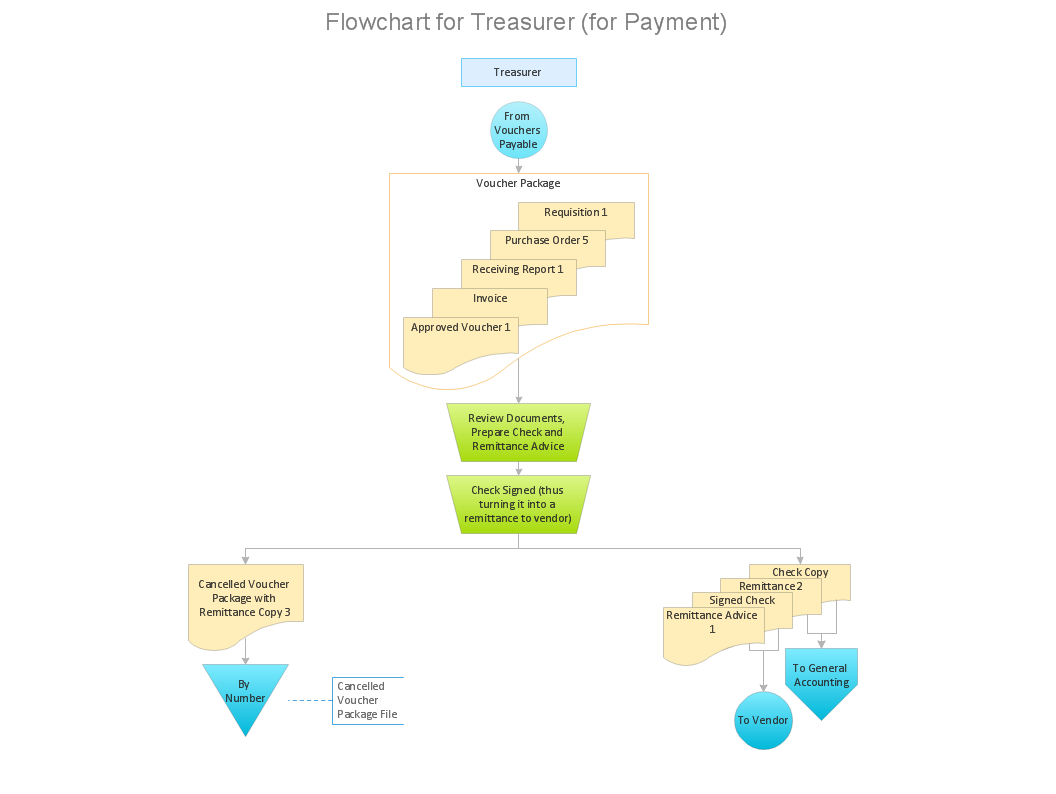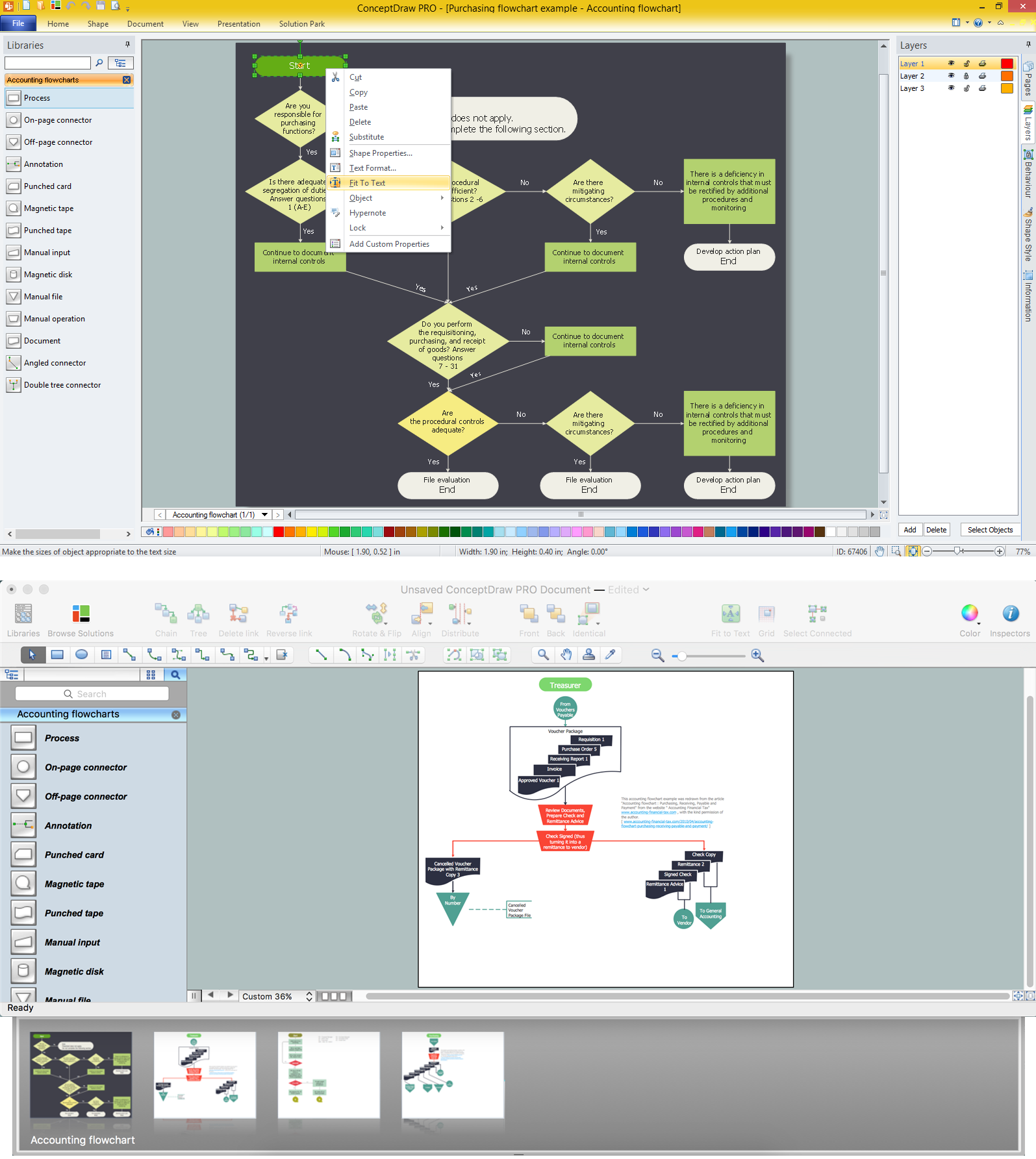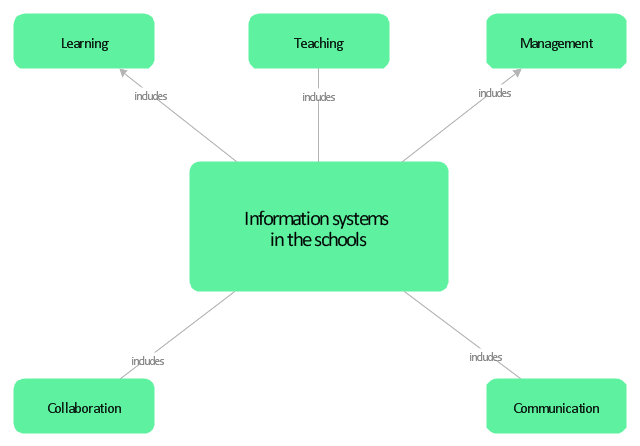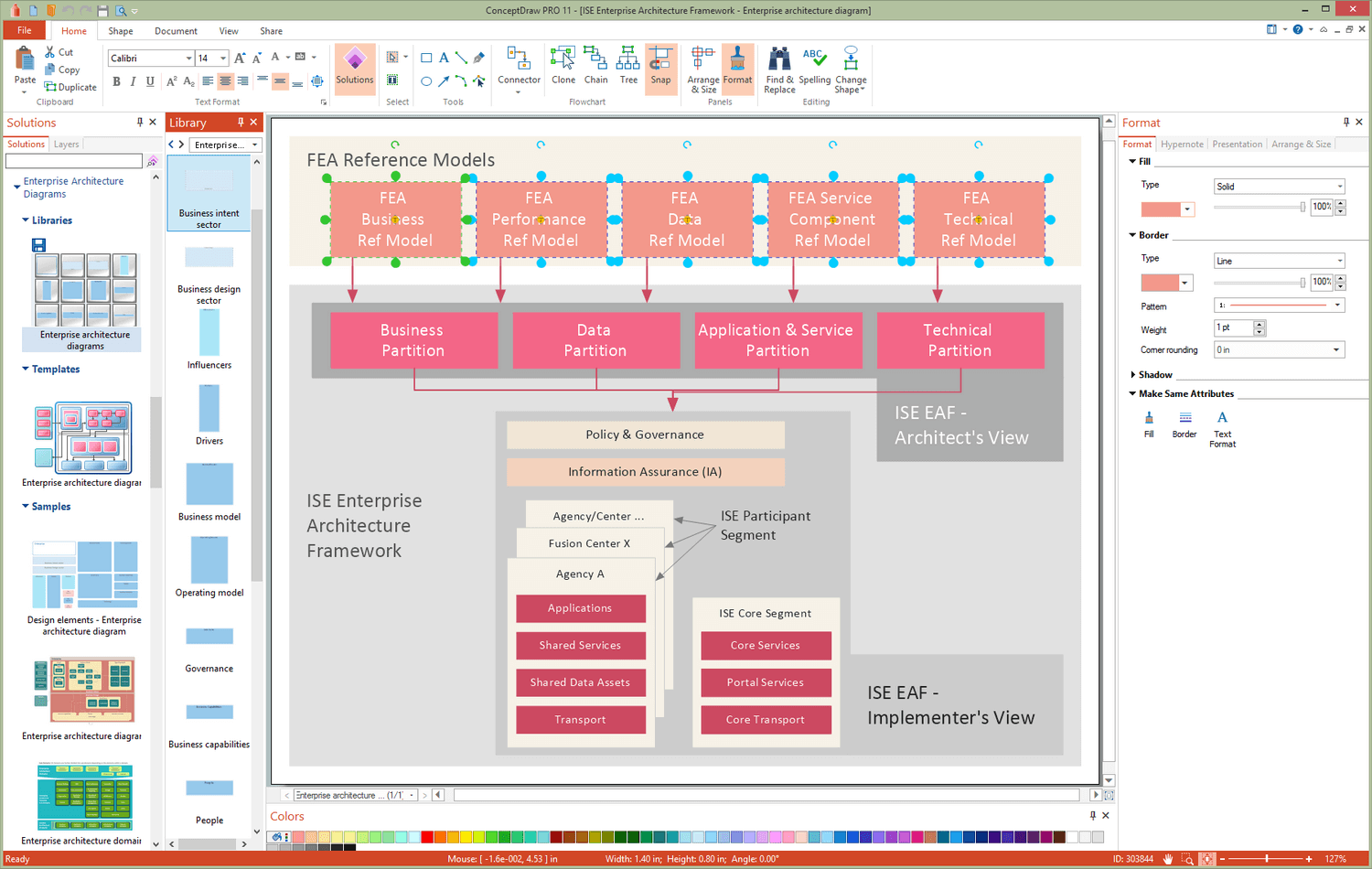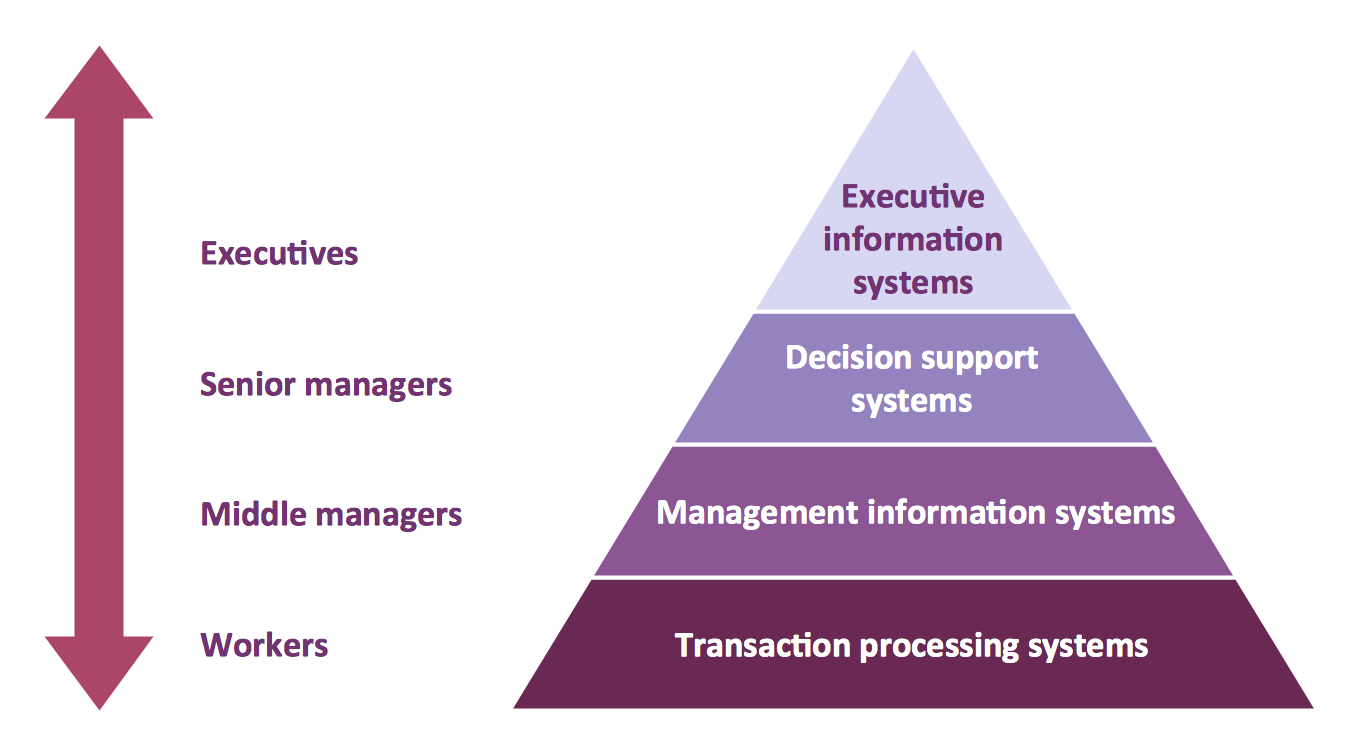Data Flow Diagram
Data Flow Diagram (DFD) is the part of the Structured Systems Analysis and Design Methodology (SSADM), which is intended for information systems projection and analysis. Data Flow Diagrams allow graphically represent the data flows in information system and analyze the data processing during the structural projection. This type of diagrams lets visually show a work of information system and results of this work, it is often used in connection with human processes and can be displayed as Workflow diagram. Data Flow Diagram visualizes processes and functions, external entities, data depositories, and data flows connecting these elements and indicating direction and data character. Each of these elements used for DFD has its own graphical notation. There are two notations to draw DFDs - Yourdon & Coad and Gane & Sarson. ConceptDraw PRO extended with Data Flow Diagrams (DFD) solution from Software Developmant area is ideal for designing professional looking DFDs, which can be then easily exported in various formats.Why Flowchart Important to Accounting Information System?
The Accounting flowchart shows how information flows from source documents through the accounting records. The are based on the accounting procedures or processes. Flowcharts are used to represent accounting information in a system . There are special symbols which are used to create accounting flowcharts. Try conceptdraw flowcharting set of symbols to draw a professional charts.Pyramid Diagram
Pyramid diagram is a chart used to visualize the data in a hierarchical (pyramid-like) structure and depict the foundation-based relationships. Pyramid diagram looks like a triangle divided by lines into several sections (layers) and can be oriented up or down, and represented in 2D or 3D view. 2D Pyramid diagrams are a great way to illustrate the hierarchical structure, 3D Pyramids are equally good to represent the class stratification and hierarchy. ConceptDraw PRO diagramming and vector drawing software with included Pyramid Diagrams solution from Marketing area of ConceptDraw Solution Park is a powerful application which contains templates and library of vector design elements for instantly drawing three level Pyramid model, four level and five level Triangle charts. All predesigned objects are easy for changing color style and resizing according to your needs, and ConceptDraw documents with Pyramid diagrams can be easy exported in various formats for further using in marketing presentations, for effective analyzing hierarchy levels and illustration your data and ideas.How to Create Flowcharts for an Accounting Information System
Accounting information is a system of interrelated processes which represent financial and accounting data, required for decision making. For representing the accounting processes in a visual and easy for perception form are constructed Accounting Flowcharts. For their creation are used special flowchart symbols, this makes Accounting flowcharts understandable for all users of accounting information system and helps them easy understand the sequence of steps involved to accounting processes. But how to create Flowcharts for an Accounting Information System fast and easy? Use of special design software is useful for this. ConceptDraw PRO software extended with Accounting Flowcharts solution is the best for creation accurate Accounting Flowcharts, for documentation and visually communication on how accounting processes work, how each operation is done. Accounting Flowcharts solution is supplied with library of predesigned commonly used vector symbols, Accounting Flowchart templates and samples demonstrating receiving, purchasing, payment, and other accounting processes."A concept map is a diagram showing the relationships among concepts, with the concepts drawn in rectangular boxes (or other shapes), which are connected with labelled lines (or arrows) that denote the relationships between concepts, such as "is a", "gives rise to", "results in", "is required by," or "contributes to". ...
The concept map can take the shape and composition of other map types. They can take the shape of the context diagram, tree diagram or venn diagram, but other shapes and compositions are also possible. ...
A concept map can be drawn with all kinds of elements:
(1) Text and lines.
(2) Blocks and arrows.
(3) Circles.
(4) Additional text.
(5) Additional listings.
(6) Additional icons.
(7) Additional Illustration (as groundplan).
(8) Additional legenda. ...
A concept map shows a number of elements, relations and/ or properties in one or more layers. ...
The relation between the elements can be pictures with specific shapes (lines, arrow)." [Concept map. Wikimedia Commons]
This concept map example was redesigned from the Wikimedia Commons file: Information systems in the Schools.jpg.
[commons.wikimedia.org/ wiki/ File:Information_ systems_ in_ the_ Schools.jpg]
This file is licensed under the Creative Commons Attribution-Share Alike 3.0 Unported license. [creativecommons.org/ licenses/ by-sa/ 3.0/ deed.en]
The example "Information systems in the schools" was created using the ConceptDraw PRO diagramming and vector drawing software extended with the Concept Maps solution from the area "What is a Diagram" of ConceptDraw Solution Park.
The concept map can take the shape and composition of other map types. They can take the shape of the context diagram, tree diagram or venn diagram, but other shapes and compositions are also possible. ...
A concept map can be drawn with all kinds of elements:
(1) Text and lines.
(2) Blocks and arrows.
(3) Circles.
(4) Additional text.
(5) Additional listings.
(6) Additional icons.
(7) Additional Illustration (as groundplan).
(8) Additional legenda. ...
A concept map shows a number of elements, relations and/ or properties in one or more layers. ...
The relation between the elements can be pictures with specific shapes (lines, arrow)." [Concept map. Wikimedia Commons]
This concept map example was redesigned from the Wikimedia Commons file: Information systems in the Schools.jpg.
[commons.wikimedia.org/ wiki/ File:Information_ systems_ in_ the_ Schools.jpg]
This file is licensed under the Creative Commons Attribution-Share Alike 3.0 Unported license. [creativecommons.org/ licenses/ by-sa/ 3.0/ deed.en]
The example "Information systems in the schools" was created using the ConceptDraw PRO diagramming and vector drawing software extended with the Concept Maps solution from the area "What is a Diagram" of ConceptDraw Solution Park.
"A concept map is a diagram showing the relationships among concepts, with the concepts drawn in rectangular boxes (or other shapes), which are connected with labelled lines (or arrows) that denote the relationships between concepts, such as "is a", "gives rise to", "results in", "is required by," or "contributes to". ...
The concept map can take the shape and composition of other map types. They can take the shape of the context diagram, tree diagram or venn diagram, but other shapes and compositions are also possible. ...
A concept map can be drawn with all kinds of elements:
(1) Text and lines.
(2) Blocks and arrows.
(3) Circles.
(4) Additional text.
(5) Additional listings.
(6) Additional icons.
(7) Additional Illustration (as groundplan).
(8) Additional legenda. ...
A concept map shows a number of elements, relations and/ or properties in one or more layers. ...
The relation between the elements can be pictures with specific shapes (lines, arrow)." [Concept map. Wikimedia Commons]
This concept map example was redesigned from the Wikimedia Commons file: Information systems in the Schools.jpg.
[commons.wikimedia.org/ wiki/ File:Information_ systems_ in_ the_ Schools.jpg]
This file is licensed under the Creative Commons Attribution-Share Alike 3.0 Unported license. [creativecommons.org/ licenses/ by-sa/ 3.0/ deed.en]
The example "Information systems in the schools" was created using the ConceptDraw PRO diagramming and vector drawing software extended with the Concept Maps solution from the area "What is a Diagram" of ConceptDraw Solution Park.
The concept map can take the shape and composition of other map types. They can take the shape of the context diagram, tree diagram or venn diagram, but other shapes and compositions are also possible. ...
A concept map can be drawn with all kinds of elements:
(1) Text and lines.
(2) Blocks and arrows.
(3) Circles.
(4) Additional text.
(5) Additional listings.
(6) Additional icons.
(7) Additional Illustration (as groundplan).
(8) Additional legenda. ...
A concept map shows a number of elements, relations and/ or properties in one or more layers. ...
The relation between the elements can be pictures with specific shapes (lines, arrow)." [Concept map. Wikimedia Commons]
This concept map example was redesigned from the Wikimedia Commons file: Information systems in the Schools.jpg.
[commons.wikimedia.org/ wiki/ File:Information_ systems_ in_ the_ Schools.jpg]
This file is licensed under the Creative Commons Attribution-Share Alike 3.0 Unported license. [creativecommons.org/ licenses/ by-sa/ 3.0/ deed.en]
The example "Information systems in the schools" was created using the ConceptDraw PRO diagramming and vector drawing software extended with the Concept Maps solution from the area "What is a Diagram" of ConceptDraw Solution Park.
Structured Systems Analysis and Design Method (SSADM) with ConceptDraw PRO
Structured Systems Analysis and Design Method (abbr. SSADM) is a method developed in Great Britain and accepted in 1993 as a national standard for information systems development and analysis. SSADM is based on Data Flow Diagrams and is characterized with presence of clear sequence of steps at projecting, analysis, and documenting of information system. It involves 6 main stages: analysis of existing system or estimation of practicability, requirements definition, determination of technical requirements and equipment cost, development of logical data model, projecting of logical requirements and specification them, physical projecting. Each of them is also divided into several steps defining the tasks that should be fulfilled at a given stage. The most important SSADM elements are flows modeling with help of DFD, data logic modeling with help of LDS (Logical Data Structure) and description of entities behavior. Applying of SSADM is easy with ConceptDraw PRO diagramming and vector drawing software and Data Flow Diagram solution.Information Architecture
You want design the Information Architecture and need a powerful software for this? ConceptDraw PRO extended with Enterprise Architecture Diagrams Solution from the Management Area is exactly what you need.Types of Flowcharts
A Flowchart is a graphical representation of process, algorithm, workflow or step-by-step solution of the problem. It shows the steps as boxes of various kinds and connects them by arrows in a defined order depicting a flow. There are twelve main Flowchart types: Basic Flowchart, Business Process Modeling Diagram (BPMN), Cross Functional Flowchart, Data Flow Diagram (DFD), IDEF (Integrated DEFinition) Flowchart, Event-driven Process Chain (EPC) Diagram, Influence Diagram (ID), Swimlane Flowchart, Process Flow Diagram (PFD), Specification and Description Language (SDL) Diagram, Value Stream Mapping, Workflow Diagram. Using the Flowcharts solution from the Diagrams area of ConceptDraw Solution Park you can easy and quickly design a Flowchart of any of these types. This solution offers a lot of special predesigned vector symbols for each of these widely used notations. They will make the drawing process of Flowcharts much easier than ever. Pay also attention for the included collection of ready Flowchart examples, samples and quick-start templates. This is business process improvement tools. If you are looking for MS Visio for your Mac, then you are out of luck, because it hasn't been released yet. However, you can use Visio alternatives that can successfully replace its functions. ConceptDraw PRO is an alternative to MS Visio for Mac that provides powerful features and intuitive user interface for the same.
Pyramid Diagram
The representation of data in a hierarchical or pyramid-like form is one of the most effective and illustrative ways of structuring the data, information, ideas in different fields, among them marketing, management, business, finances, sales, consulting, media, and some others. Pyramid Diagram perfectly suits for this goal, especially if we talk about the representing some marketing strategies, information systems, social strategies. Pyramid Diagram looks like a triangle or reversed triangle that is divided visually on several layers. Each layer can be colored with its own color, this lets visually highlight important moments. ConceptDraw PRO diagramming and vector graphics software extended with Pyramid Diagrams solution from the Marketing area provides powerful drawing tools, templates, samples, and built-in vector pyramid objects, thus all required tools for equally easy drawing Three level pyramid diagram, Four level pyramid model, Five level pyramid, etc., at this your Pyramid diagrams can have 2D or 3D view as you like.- 4 Level pyramid model diagram - Information systems types ...
- Simple Diagram The Concept Of Information System
- 4 Level pyramid model diagram - Information systems types | With ...
- Explain In Detail Organizational Pyramid And Information Concept
- Concept Of Information
- 5 Level pyramid model diagram - Information systems types ...
- Mis Management Information System Block Diagram
- Location Of Mis In Organization Concepts Nd Diagram
- Concept Map Of Charts Of Accounts
- Explain Information System With The Help Of Block Diagram

